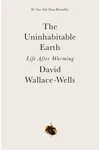Picture an American journalist who turned climate change into a gripping wake-up call—meet David Wallace-Wells! With his 2019 bestseller The Uninhabitable Earth: Life After Warming, he painted a vivid, urgent picture of our planet’s future, blending meticulous research with a storyteller’s flair. His work doesn’t just inform—it shakes you to act.
Born in 1982 in Manhattan’s Inwood neighborhood, Wallace-Wells grew into a voice that demands attention, challenging readers to face the stark realities of global warming. From New York Magazine to The New York Times, his journey as a climate journalist is one of bold truths and a cautious optimism that keeps hope alive.
The Making of David Wallace-Wells
Raised in Riverdale after his early years in Manhattan, David Wallace-Wells was shaped by a family with deep roots. His maternal grandparents, German Jews who fled Nazi Germany in 1939, instilled resilience, while his academic father and kindergarten-teacher mother fostered curiosity. This blend of grit and intellect led him to journalism, starting as a literary editor at New York Magazine in 2011. His early career also included a stint as deputy editor at The Paris Review and a fellowship at the New America Foundation, sharpening his ability to weave complex ideas into compelling narratives.
David Wallace-Wells’s Unforgettable Stories
Wallace-Wells’s breakout came with his 2017 New York Magazine article “The Uninhabitable Earth,” a chilling exploration of climate change’s worst-case scenarios. It became the magazine’s most-read piece ever, striking a nerve with its vivid prose and unflinching honesty. Expanded into the 2019 book The Uninhabitable Earth: Life After Warming, it outlines twelve interconnected “plagues”—from rising seas to disease outbreaks—showing how warming reshapes politics, culture, and survival. Critics praised its lyrical intensity, with The Washington Post calling it “this generation’s Silent Spring.”
His style avoids the dry jargon of climatology, opting for lush, urgent prose that feels almost biblical. Beyond his flagship work, Wallace-Wells has tackled the COVID-19 pandemic and technology’s future, writing columns and newsletters for The New York Times since 2022. His 2021 podcast 2038, co-hosted with experts, probes predictions for the next two decades, blending journalism with speculative insight. Each piece carries his signature: meticulous research, a storyteller’s heart, and a call to confront hard truths.
While some scientists initially criticized his 2017 article for leaning too heavily on worst-case scenarios, Wallace-Wells defends his approach, arguing that fear can spur action. His work doesn’t dwell on despair but pushes for solutions like carbon taxes and green energy, making the crisis feel both urgent and actionable.
Why David Wallace-Wells Matters
David Wallace-Wells has redefined climate journalism, making it accessible and urgent for a broad audience. His ability to translate complex science into human terms has galvanized readers, policymakers, and activists. By framing climate change as a story we’re all writing, he empowers collective action, reminding us that every choice shapes the planet’s future. His influence extends beyond books—his talks, like those at the University of Colorado’s Climate Summit, inspire hope amid crisis.
His work also challenges complacency, urging a generation to act before the “uninhabitable” becomes reality. As climate impacts intensify, Wallace-Wells remains a vital voice, blending alarm with optimism to drive change.
About David Wallace-Wells
- Born: 1982 in Manhattan, New York
- Key Works: The Uninhabitable Earth (2019), “The Uninhabitable Earth” article (2017)
- Notable Roles: Deputy Editor at New York Magazine, Columnist at The New York Times
- Fun Fact: Co-hosted the 2038 podcast exploring future predictions
Snag The Uninhabitable Earth and dive into David Wallace-Wells’s urgent, eye-opening world of climate storytelling!
